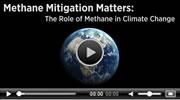Importance of Methane
Methane (CH4) is a hydrocarbon that is a primary component of natural gas. Methane is also a greenhouse gas (GHG), so its presence in the atmosphere affects the earth’s temperature and climate system. Methane is emitted from a variety of anthropogenic (human-influenced) and natural sources. Anthropogenic emission sources include landfills, oil and natural gas systems, agricultural activities, coal mining, stationary and mobile combustion, wastewater treatment, and certain industrial processes.
Methane is the second most abundant anthropogenic GHG after carbon dioxide (CO2), accounting for about 20 percent of global emissions. Methane is more than 25 times as potent as carbon dioxide at trapping heat in the atmosphere. Over the last two centuries, methane concentrations in the atmosphere have more than doubled, largely due to human-related activities. Because methane is both a powerful greenhouse gas and short-lived compared to carbon dioxide, achieving significant reductions would have a rapid and significant effect on atmospheric warming potential.
- Visit EPA's Methane page for detailed information about sources of methane, trends, and projections of future methane emissions
- Read GMI's fact sheet, Global Methane Emissions and Mitigation Opportunities Exit
Other Things to Know About Methane Emissions
- Who are the biggest methane emitters?
China, the United States, Russia, India, Brazil, Indonesia, Nigeria, and Mexico are estimated to be responsible for nearly half of all anthropogenic methane emissions. The major methane emission sources for these countries vary greatly. For example, a key source of methane emissions in China is coal production, whereas Russia emits most of its methane from natural gas and oil systems. Oil and gas systems are the largest source of U.S. methane emissions (29 percent), followed by livestock enteric fermentation (26 percent).
- Why aren’t efforts to capture and profitably use methane emissions more widespread?
Despite multiple benefits, methane recovery is not widespread for several reasons.
- Methane is generally a secondary byproduct in the industrial processes from which it is emitted. Coal mines, for example, seek to vent methane from the mine workings because it can cause explosions. Historically, mining companies have not viewed the associated methane as an energy resource in its own right.
- Those responsible for the emissions may not be familiar with the technologies available for methane recovery or the potential for profitable recovery projects. This is especially true in developing countries where improved access to information and technical training would be beneficial to generating support for methane recovery projects.
- Poorly functioning energy markets and financially insolvent utilities and municipalities within many countries fail to provide the private sector with a climate that will attract their investment in projects to capture and utilize methane.

